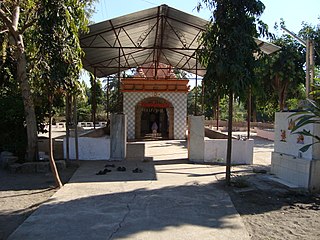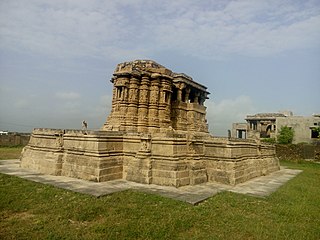Lunavada is a municipality in the Mahisagar district, formerly in the northern part of Gujarat state of India.
Bhanvad is a city and a municipality in Devbhoomi Dwarka district in the state of Gujarat, India.

Kodinar is a town and municipality in Gir Somnath district, in the Indian state of Gujarat, 37 kilometres (23 mi) west of Una. Kodinar is close to the Gir Forest National Park. The main transport connections for Kodinar are Diu Airport, Veraval Junction railway station, and Veraval Port.
Jethwa is a clan of Rajputs and Koli castes of Gujarat. Jethwa surname is also found among Darji, Mistris of Kutch, Gurjar Kshatriya Kadias castes of Gujarat

Graharipu was a 10th-century Chudasama king of Saurashtra region of western India with his capital at Vamanasthali. He was a contemporary of Mularaja, the first Chaulukya ruler of Anahilapataka. Graharipu built or repaired Durgapalli, the ancient fort in Junagadh identified as Uparkot.

Ghumli is a village located 45 km from Jamkhambhaliya, at foothills of Barda, in Devbhumi Dwarka district of Gujarat, India.

The Kalleshvara temple is located in Aralaguppe, a village in the Tiptur taluk of Tumkur district, in the Indian state of Karnataka.

A sun temple is a building used for religious or spiritual activities, such as prayer and sacrifice, dedicated to the sun or a solar deity. Such temples were built by a number different cultures and are distributed around the world including in India, China, Egypt, Japan and Peru. Some of the temples are in ruins, undergoing excavation, preservation or restoration and a few are listed as World Heritage Sites individually or as part of a larger site, such as Konark.

Bhadreshwar Jain Temple, also known as Vasai Jain Temple, is a historical importance located in Bhadreshwar village of Mundra Taluka, Kutch, Gujarat, India.

The Gop temple is a Sun temple located at Zinavari village in Jamjodhpur Taluka of Jamnagar district, Gujarat, India. The Hindu temple is dated to the 6th century and is one of the earliest surviving stone temples in Gujarat. The original temple had a square plan, a mandapa and covered circumambulation passage which are lost, and a pyramidal masonry roof which is ruined but whose partial remains have survived. The temple has a height of 23 feet (7.0 m) which includes a small tower. The roof of the tower is decorated with arch-like gavaksha window shapes below an amalaka cogged wheel-shaped crown.

Jasmalnathji Mahadev Temple is a Hindu temple located at Asoda village in Vijapur Taluka, Mehsana district, Gujarat, India. It is locally known as Vaijnath Mahadev temple. The temple is dedicated to Shiva. The temple is built in the 12th century. It consists of a sanctum; mandapa and torana, a porch.
Bhima II, also known as Bhola Bhima, was an Indian king who ruled parts of present-day Gujarat. He was a member of the Chaulukya dynasty. During his reign, the dynasty's power declined greatly as a result of rebellions by the feudatories as well as external invasions by the Ghurids, the Paramaras, and the Yadavas of Devagiri. The kingdom, however, was saved by his generals Arnoraja, Lavanaprasada and Viradhavala, whose family established the Vaghela dynasty.

The Saindhavas, also known as Jayadrathas, was a Medieval Indian dynasty that ruled western Saurashtra from c. 735 CE to c. 920 CE, probably in alliance with Maitrakas in its early years. Their capital was at Bhutamabilika. The known historical events during their rule are the attacks of Arabs repulsed by Agguka I.

Uparkot is a fort located in east side of Junagadh, Gujarat, India.

The Rama Lakshamana Temples or Samba Lakshamana Temples are the late 12th century twin Hindu temples in Baradia, a village in Okhamandal region of Devbhoomi Dwarka district, Gujarat, India. Baradia is about five km southeast of Dwarka. There are some temples near the coast within the limits of the village.
Khengara was a Chudasama king of Saurashtra region of western India who reigned in the 12th century. His capital was at Junagadh. He was a contemporary of Jayasimha Siddharaja, the Chaulukya ruler of Anahilapataka. According to bardic tales, he was a son of Navaghana and had succeeded him.
Jethwa dynasty was a dynasty that ruled over present day Gujarat region of India from 7th century AD till middle of 20th century, when India became independent. It was a Rajput dynasty ruled by Jethwa clan of Rajputs.
The Architecture of Gujarat consists of architecture in the Indian state of Gujarat.
Panchasara Parshwanath Temple is a Śvetāmbara Jain temple located in Patan, Gujarat. The temple was constructed in 8th century during the reign of Vanaraja Chavda of Chavda dynasty.

Brahma Temple or Brahmaji Mandir is a Hindu temple dedicated to Brahma in Khedbrahma, Gujarat, India. It is built in third quarter of the 11th century.















